
Key Takeaways
- Tennessee has five categories of private schools — each with different accreditation and approval standards and requirements for curriculum, testing, and teacher qualifications.
- Lee proposes giving students about $7,100 per year for the costs and expenses of attending private school, which would be available to all 1.1 million of Tennessee’s school-aged children in the 2025-2026 school year.
- There are some similarities between the proposed Education Freedom Scholarships and the existing Education Savings Account program but also many key eligibility differences.
- Tennessee has 626 private schools in 76 counties and 95 school districts.
- In 2021-2022, about 960,000 Tennessee children — or 85% of all school-aged kids — were enrolled in public schools, but reliable data on where the remaining 165,000 were enrolled aren’t available.
This year, the General Assembly will consider Governor Bill Lee’s Education Freedom Scholarship Act to financially support students attending private schools. This report explains what we know about the proposal, highlights differences with an existing program, and provides context and data on Tennessee’s current private school landscape.
Note: This report is based on official information (cited throughout) on the Education Freedom Scholarship Act available at the time of publication.
Private School Types in Tennessee
Tennessee defines and categorizes several different types of public and nonpublic schools to inform compliance with state law requiring all children ages 6-17 to attend school (Figure 1). Public schools are those operated with public dollars by a local school district or the state (i.e., traditional public schools) and those operating under a charter agreement with a local district or the state (i.e., public charter schools). Nonpublic schools include private schools that are either directly approved by the state or accredited/affiliated with an organization approved by the state. Home schools also meet the definition of nonpublic schools. (1) (2) (3)
Figure 1
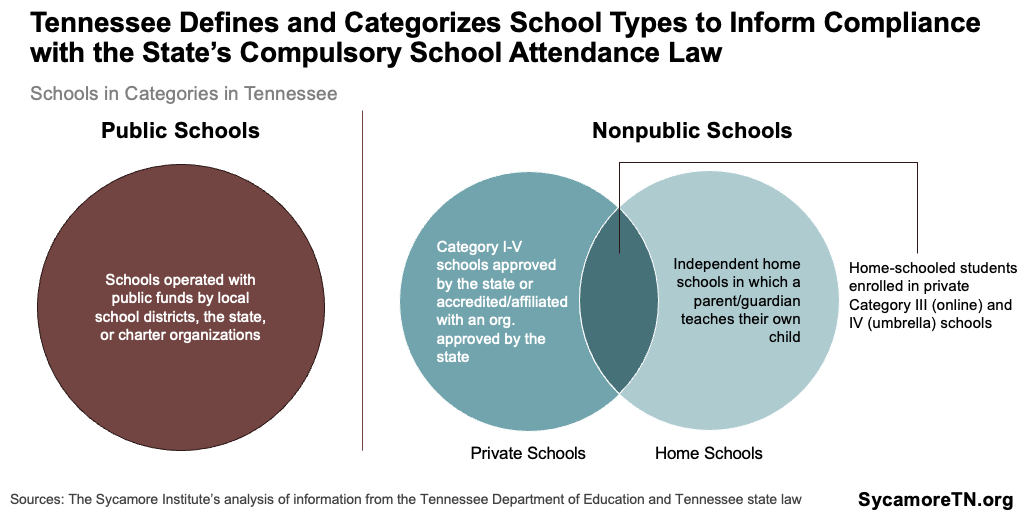
Tennessee has five categories of private schools — each with different requirements for accreditation, approval, curriculum, testing, and teacher qualifications. Table 1 provides a high-level overview of the requirements associated with each category. Category I, II, and III schools are subject to the most requirements. Category IV church-related schools have fewer, and Category V schools are often in the process of meeting the requirements of one of the other categories. (6) (7)
Home-schooled children can fit into more than one category of nonpublic schools. Independent home schools are those in which a parent or guardian is teaching their children. However, many home-school children may also be enrolled in Category III and IV private schools. Some Category III schools are accredited to provide online learning options, and Category IV includes many church-related umbrella schools, which offer various services to supplement home schooling. (4) (5) For example, families can enroll in Home Life Academy — Tennessee’s largest Category IV school — for about $100 per year (depending on a student’s age). Enrollment gives them access to curriculum resources and counseling, online record-keeping, and discounts for third-party services (e.g., language courses, tutoring services). Additional services are available for additional fees (e.g., $5 for a transcript, $25 per semester for grade reporting assistance). (8)
Table 1
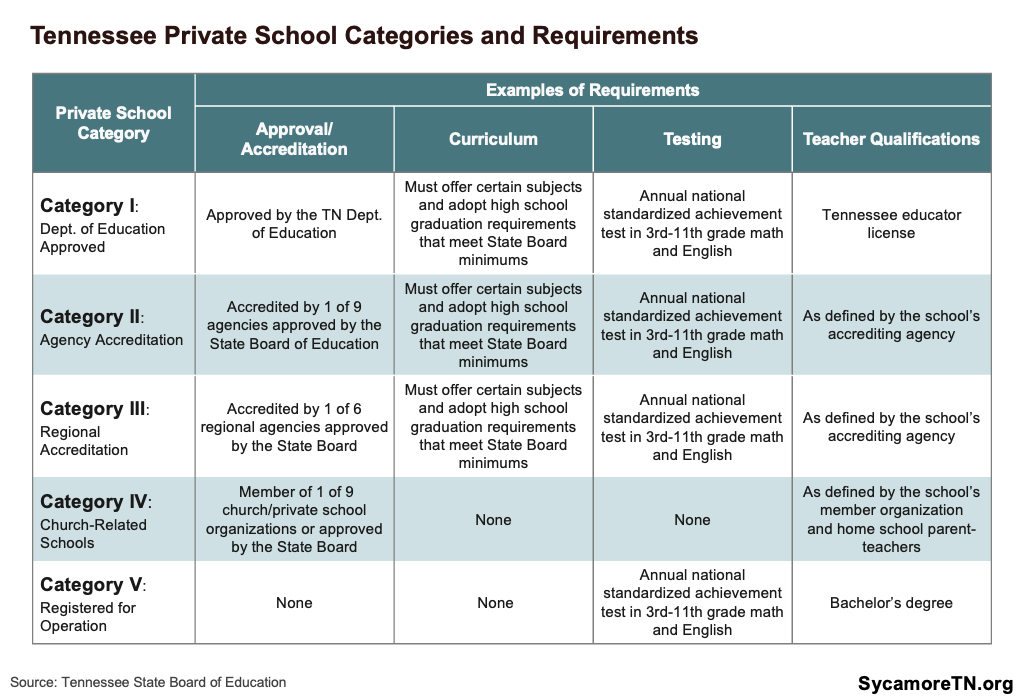
What’s Proposed
The Education Freedom Scholarship Act proposes giving Tennessee students about $7,100 per year for the costs and expenses of attending private school. The program would increase over two years — with 20,000 scholarships available for the 2024-2025 school year and universal access in 2025-2026. Half of the first year’s scholarships would be reserved for students eligible for the existing Education Saving Account (ESA) program (see below), those under 300% of the poverty line, and those with disabilities. The remaining half would be available for any student. (9)
There are some similarities between the proposed Education Freedom Scholarships and the existing ESA program but also many key differences. (10) (9) The ESA program was enacted in 2019 and first became available to students in the 2022-2023 school year. Tennessee also has a similar Individualized Education Account (IEA) program for students with disabilities. To date, no changes have been proposed to either existing program. Similarities and differences between ESAs and the governor’s proposal include:
Similarities
- Funds under both programs are available to students and their families through individual accounts. In both programs, recipients can use funds for similar types of expenses. These include private school tuition, fees, textbooks, uniforms, and other education-related expenses like transportation costs, tutoring services, computers, and educational therapy.(11)
Student Eligibility Differences
- ESA eligibility is restricted to students whose family income meets certain guidelines and are zoned for one of four districts that meet specific school performance criteria. Family incomes are capped at twice the eligibility levels of the free lunch program — which is about $78,000 for a family of 4 for the current school year. (11) ESA school district criteria translate to only three local education agencies — the Metro Nashville-Davidson County, Hamilton County, and Memphis-Shelby County School Districts. Students must also be previously enrolled or newly eligible to enroll in a Tennessee public school. (12)
- Once fully implemented, the proposed Education Freedom Scholarships would be universal — available to children of all income levels statewide. In 2022, Tennessee had about 1.1 million school-age children.(13) Low-income students and those already enrolled in Tennessee public schools would have priority, but all students would be eligible.
School Eligibility Differences
- ESAs can only be used to attend a private school approved as a Category I, II, or III school (discussed later), and schools must apply to receive ESAs. Today, about 11% of the state’s private schools across all categories are approved to receive ESA funds (Figure 2).(14) Home school students — including those enrolled in a Category IV home school umbrella school — are not eligible for ESAs.
- Full details of school eligibility for Education Freedom Scholarships are not yet available. However, available information explicitly says that independently home-schooled children would not be eligible unless they enroll in Category IV schools. This could potentially create an incentive for more independent home school students to enroll in an umbrella school.
Testing
- ESA students in 3rd-8th grades must take state tests in both math and English each year, and aggregated results are posted online.
- There are currently no testing requirements proposed for students receiving an Education Freedom Scholarship beyond the existing requirements for the schools in which they are enrolled (Table 1).
Other Differences
- State law ramps up the maximum number of ESAs over time from 5,000 in the first year (2022-2023) to 15,000 in the fifth year (2026-2027) and beyond. The proposed Education Freedom Scholarships would be a universal program by the 2025-2026 school year.
- The average state and local per pupil amount calculated under the state’s school funding formula determines ESA amounts, which was about $8,200 for the 2022-2023 school year.(15) Lee’s new scholarship proposal sets amounts at $7,075 for the 2024-2025 school year. It is not yet clear how this amount might change over time.
Figure 2
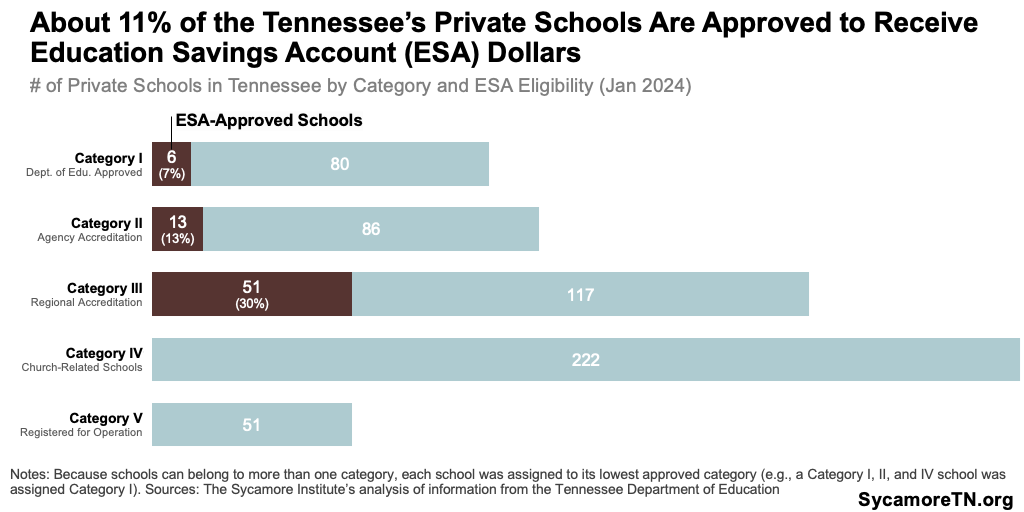
Figure 3
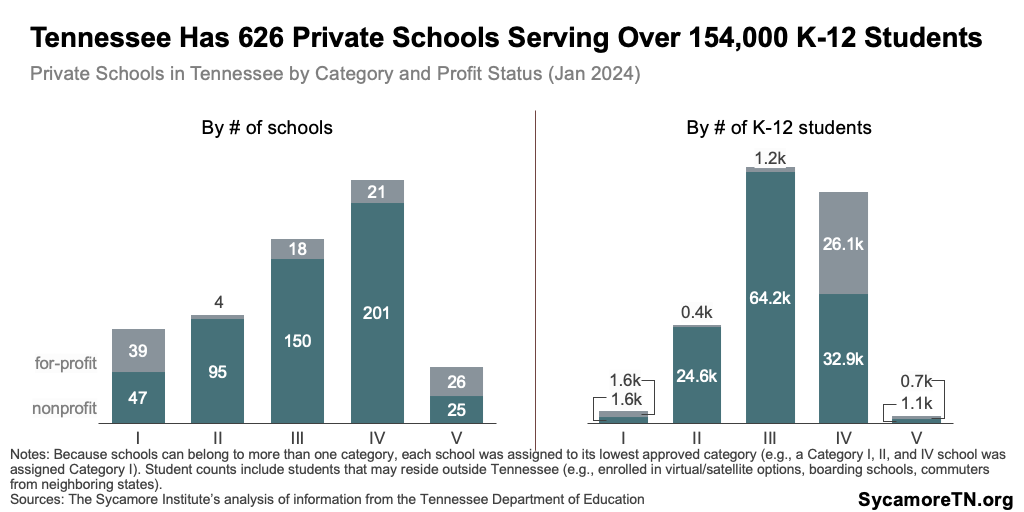
Tennessee’s Private School Landscape
Tennessee had 626 private schools in 76 counties (and 95 school districts) with over 154,000 K-12 students as of January 2024. These counts include an uncertain number of out-of-state students enrolled in virtual/satellite options, attending boarding schools, or commuting from other states. The rest of this report provides additional information on home and private schooling in Tennessee. Figures 3 and 4 provide statewide information on the number of private schools and students at those schools. Explore this information at the school district level using the Dashboard. Because schools can belong to multiple categories, we assigned each school to the lowest category to which it belongs (e.g., if a school belonged to Categories I, III, and IV, it was categorized as Category I). (14) (16)
The state comptroller’s office also offers two dashboards with more specific details on each private school and its enrollment. They are available here.
Figure 4
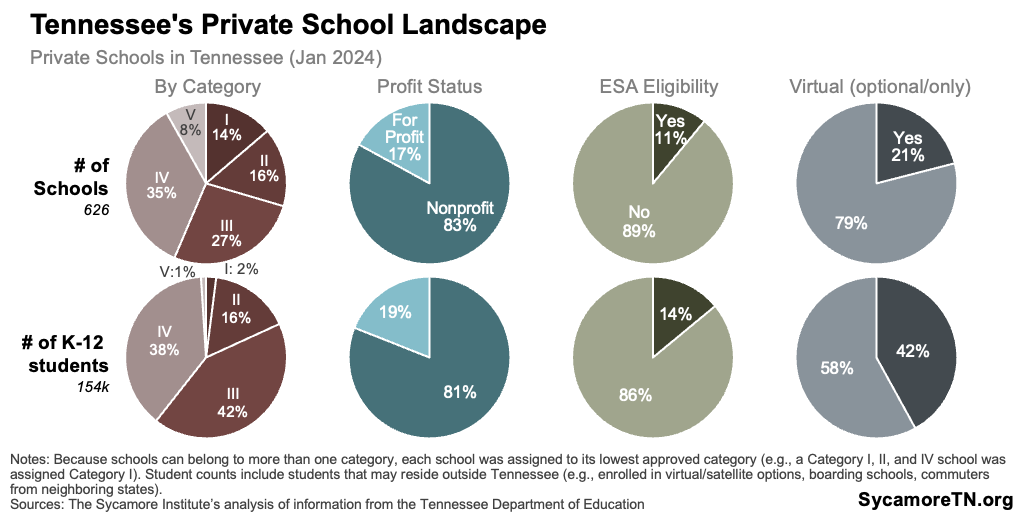
Private and Home School Enrollment in Tennessee
In 2021-2022, about 960,000 Tennessee children — or 85% of all school-age kids — were enrolled in public schools, but reliable data on where the remaining 165,000 were enrolled aren’t available. (13) (17) (18) Here is what we do and don’t know about nonpublic school enrollment:
- The Tennessee private school data above includes counts of children from out-of-state and do not include children attending only independent home schools.
- In 2022, private or home schools enrolled as many as 172,000 Tennessee kids (or about 16%) according to Census Bureau estimates. That number exceeds other estimates and isn’t broken down by school category.(19)
- A study by the Urban Institute estimated that about 98,500 (or 9%) were enrolled in private schools in the Fall of 2021, and another 13,600 (or 1%) were in home schools. This study, however, could not account for almost 89,000 children (or 5%), and there is no information on how children who are primarily home-schooled but also enrolled in virtual/umbrella options were categorized.(18)
Although they may be imprecise, Census estimates provide a general picture of trends and geographic differences in nonpublic school enrollment in Tennessee. For example, the number and percentage of private and home school students in Tennessee have increased steadily since 2015 – with significant increases during the pandemic and a slight dip in 2022 (Figure 5). Across the state, these estimated proportions varied from a low of 1% in Clay County to a high of 38% in Pickett County for the 2018-2022 period (Figure 6). (20)
Figure 5
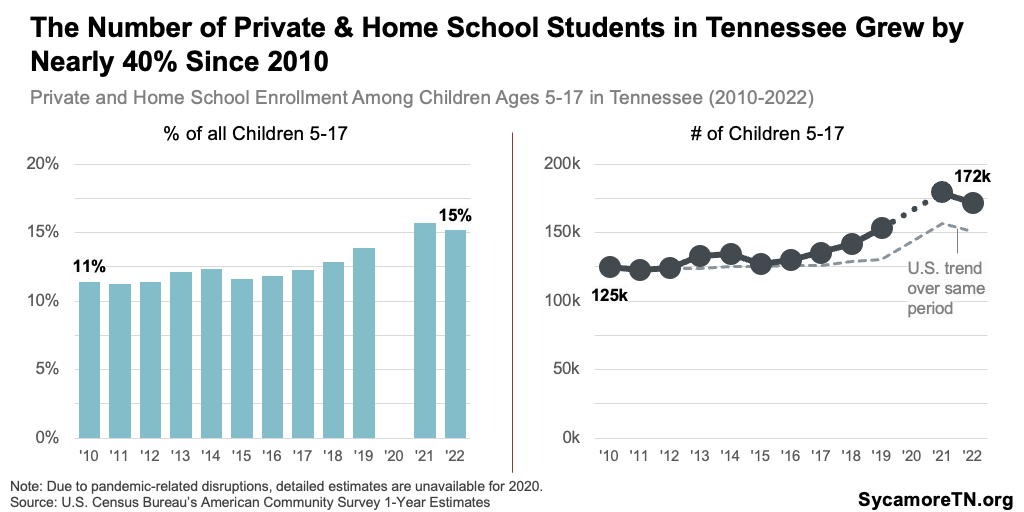
Figure 6
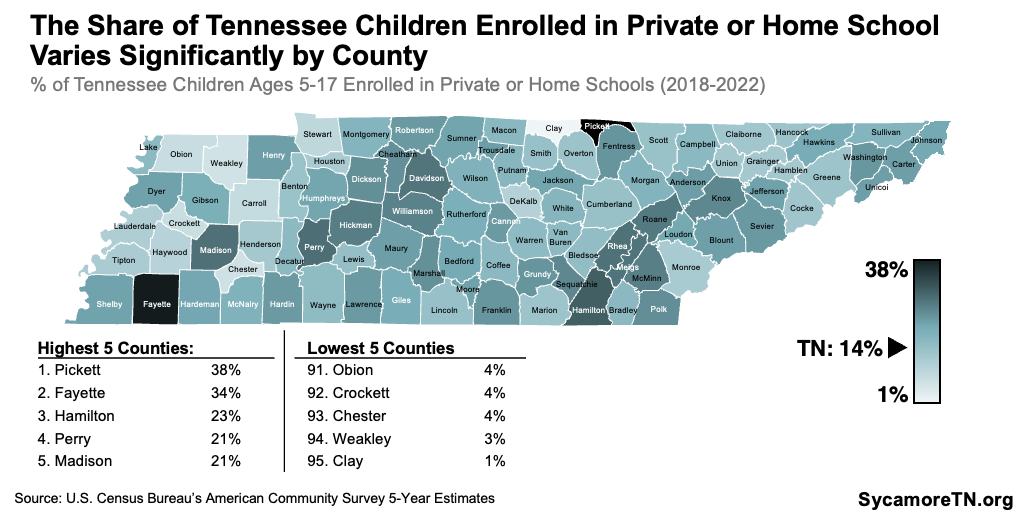
Explore the Data
Use the interactive map below for private school data by school district, nonprofit status, and school category.
References
Click to Open/Close
References
- State of Tennessee. Tenn. Code Ann. § 49-6-3001. Accessed on January 30, 2024 via Lexis.
- Tennessee Department of Education. Education Choices in Tennessee. [Accessed on January 30, 2024.] https://www.tn.gov/education/families/school-options.html.
- State of Tennessee. Tenn. Code Ann. § 49-13-104. Accessed on January 30, 2024 via Lexis.
- —. Tenn. Code Ann. § 49-6-3050 . [Online] [Cited: January 30, 2024.] Accessed via Lexis.
- Tennessee Department of Education. Home School. [Accessed on January 26, 2024.] https://www.tn.gov/education/families/school-options/home-schooling-in-tn.html.
- Tennessee State Board of Education. Policy 3.500: Category II and III Private School Accrediting Agencies. February 10, 2023. https://www.tn.gov/content/dam/tn/stateboardofeducation/documents/2023-sbe-meetings/february-10%2c-2023-sbe-meeting/2-10-23%20IV%20K%20Category%20II%20and%20III%20Private%20Accrediting%20Agencies%20Policy%203.500%20Clean.pdf.
- —. Rule: Chapter 0520-07-02 Non-Public School Approval Process. August 2023. https://publications.tnsosfiles.com/rules/0520/0520-07/0520-07-02.20230815.pdf.
- Home Life Academy. [Accessed on January 31, 2024.] https://homelifeacademy.com/.
- State of Tennessee. Education Freedom. [Accessed on January 26, 2024.] https://tneducationfreedom.com/.
- —. Tenn. Code Ann. § 49-6 Part 26 – Tennessee Education Savings Account Pilot Program. Accessed on January 26, 2024 via Lexis.
- Tennessee Department of Education. Family Handbook: A Guide to the Education Savings Account (ESA) Program SY 2023-2024. https://www.tn.gov/content/dam/tn/education/esa/ESA_Family_Handbook_23-24.pdf.
- —. ESA Program Eligibility Worksheet 2023-24. [Accessed on January 30, 2024.] https://www.tn.gov/content/dam/tn/education/esa/ESA-Program-Eligibility-Worksheet-23-24_updated.pdf.
- U.S. Census Bureau. Annual Estimates of the Resident Population for Selected Age Groups by Sex: April 1, 2020 to July 1, 2022 (SC-EST2022-AGESEX). December 2023. https://www.census.gov/data/tables/time-series/demo/popest/2020s-state-detail.html.
- Tennessee Department of Education. Current List of Non-Public Schools. January 2, 2024. https://www.tn.gov/education/families/school-options/non-public-schools.html.
- —. Frequently Asked Questions for Participating Families SY 2023-2024. [Accessed on January 26, 2024.] https://www.tn.gov/content/dam/tn/education/data/acct/ESA-FAQ-for-Participating-Families_23-24_Update_Comms.pdf.
- U.S. Census Bureau. SAIPE School District Estimates for 2022. December 2023. Accessed from https://www.census.gov/data/datasets/2022/demo/saipe/2022-school-districts.html.
- Tennessee Department of Education. 2022 Annual Statistical Report: Table 9 – 1st Month Membership. 2023. https://www.tn.gov/education/districts/federal-programs-and-oversight/data/department-reports/2022-annual-statistical-report.html.
- Dee, Thomas S. Where the Kids Went: Nonpublic Schooling and Demographic Change during the Pandemic Exodus from Public Schools. Urban Institute. February 2023. https://www.urban.org/sites/default/files/2023-02/Where%20the%20Kids%20Went-%20Nonpublic%20Schooling%20and%20Demographic%20Change%20during%20the%20Pandemic%20Exodus%20from%20Public%20Schools_0.pdf.
- U.S. Census Bureau. American Community Survey Questionnaire. [Accessed on January 26, 2024.] https://www2.census.gov/programs-surveys/acs/methodology/questionnaires/2024/quest24GQ.pdf.
- —. American Community Survey 1- and 5-Year Estimates. Accessed via http://data.census.gov.
















